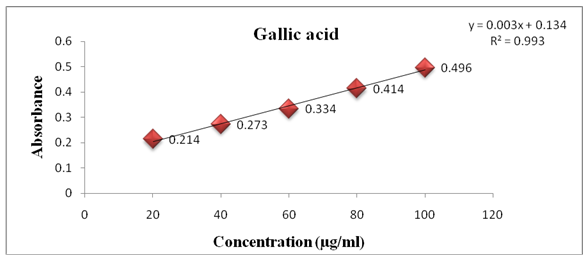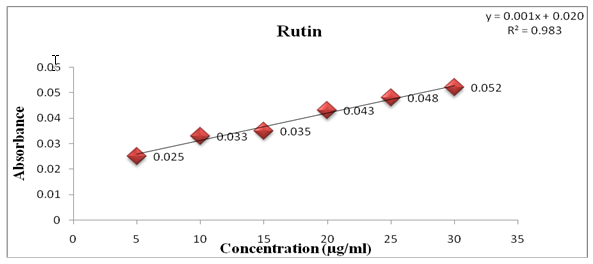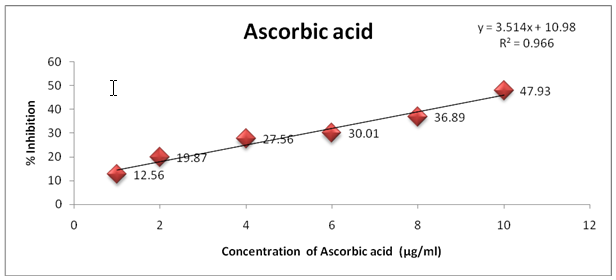 About Authors:
About Authors:
Devendra Kumar1*, Pragya Seth2
Department of Pharmaceutical technology,
1 Sri Satya Sai collage of Pharmacy Bhopal, India
2 Lakshmi Narayana College of Pharmacy Bhopal, India
Abstract:
Antioxidants play a significant role in protecting the body against free radical damage. Antioxidants refer to a group of compounds that are able to delay or inhibit the oxidation of lipids or other biomolecules and thus, prevent or repair the damage of the body cells that is caused by oxygen. Prunus amygdalus is used in traditional for the cure of ulcer. Since the activity may be correlated with the presence of antioxidant compound were evaluated for their total phenolic content (TPC), total flavonoid content (TFC), ferric reducing ability (parameter (FRAP), 1,1-diphenylpicrylhydrazyl (DPPH) in extract of Prunus amygdalus fruit.
[adsense:336x280:8701650588]
Reference Id: PHARMATUTOR-ART-1233
Introduction
Prunus amygdalusBatsch (Rosaceae) is an indigenous small tree in the region of the Mediterranean Sea. The edible portion of Prunus amygdalus is its nuts known as almonds and is a popular nutritious food. Nuts of Prunus amygdalus are found to posssess various pharmacological properties, such as antistress, antioxidant, immunostimulant, lipid lowering and laxative. The nuts of Prunus amygdalus are mentioned as medhyarasayana (nootropic agent) in the classical Ayurvedic tests and are also used in folklore practice (Kulkarni et al.).
Antioxidants play an important role in defending the body against free radical damage. Antioxidants refer to a group of compounds that are able to delay or inhibit the oxidation of lipids or other biomolecules and thus, prevent or repair the damage of the body cells that is caused by oxygen. Antioxidants prevent the formation of free radical species, existing free radicals and chained reaction. For example, phenolic compounds (quercetin and ellagic acid) are potent antioxidant that is capable to protect body cells from injuries caused by reactive ROS and nitrogen species (Ismail et al.). Almonds fruit (P. amygdalus) have three separate parts: the inner kernel (meat), the middle shell portion, and an outer green shell cover (hull). Almond varieties differ in shell texture; hence they are known as hard or soft shelled. The procedure of harvesting begins when the almonds are somewhat dried on the trees (Esfahlan et al.).
The antioxidant activity of extracts was evaluated by ability to scavenge the 1, 1-diphenyl-2-picryl-hydrazyl (DPPH) radical (Pinelo et al.).
The radical scavenging capacity (RSC) of pure substance or plant extracts can be determined by the trapping of synthetic and stable radical in the solution of methanol at room temperature. In this test, the scavenging of DPPH radical is assessed by monitoring the decrease in absorbance at 515 nm due to reduction by the antioxidant (Argolo et al.).
Method and Material
The fresh fruit of almond were collected in the month of December from asha provision jawahar chock shop no. 18 Bhopal. All the chemicals were of analytical grade. Solvent for the extraction were purchased from Merck specialities private limited Mumbai.
Extraction of fruits
Soxhlet method
Dried and powdered fruits of almond were extracted with petroleum ether and methanol. After extraction were evaporated to dryness to yield 30% and 3% in petroleum extract and methanol extract respectively.
Determination of antioxidant activity
A. Total flavonoid content
0.5 ml of sample and 2.5 ml of distilled water were added to 0.15 ml of 5% NaNO2 solution. After 6 min add 0.15 ml of 10% AlCl3 to the solution, After 5 min add 1 ml of 1M NaOH and measure the absorbance immediately at 510nm.
Requirement
a. Standard curve of rutin (10-100µg/ml).
b. 1mg/ml solution of extract.
B. Total Phenolic content
1 ml test sample (1mg/ml) and 5 ml follin ciocalteu’s phenolic reagent were added to 4 ml 7.5% Na2CO3 30 min incubation in dark / shade absorbance taken at 760 nm with the help of standard gallic acid curve, total phenolic content was known in µg/ml.
Requirement
a. Standard curve of gallic acid (10-100µg/ml).
b. 1mg/ml solution of extract.
C. DPPH Free radical scavenging assay
1 mg extract powder will be dissolved in 1 ml of 90% methanol solution to obtain 1000 µg/ml sample solution. 1000 µg/ml solutions will be series diluted into concentration ranging from 25-150 µg/ml (i.e. 25, 50, 75, 100, 125, 150 µg/ml). 200 µM solution of DPPH in methanol will be prepared and 1.5 ml of this solution will be added to 1.5 ml of methanol extract solution at different concentrations (25-150 µg/ml). Ascorbic acid will be used as the standard control, with concentrations ranging from 2-20 µg/ml (i.e. 2, 5, 10, 15, 20 µg/ml).Thirty minutes later, the absorbance will be measured at 517 nm. The absorbance of DPPH solution decreases when kept in contact with antioxidant test sample and free radical scavenging activity is inversely proportional to the absorbance of DPPH solution. The same procedure will be followed, to study DPPH free radical scavenging assay of aqueous extract. Percent inhibition of DPPH free radical scavenging activity will be calculated using the following formula,

Where Acont is the absorbance of the control reaction, & Atest is the absorbance in the presence of the sample of the extracts.
[adsense:468x15:2204050025]
RESULT
Solubility test:
a. Extract was soluble in water and partially soluble in methanol.
b. Extract was insoluble in hexane and petroleum ether and chloroform.
Extraction yield
Present the yield, of petroleum ether and methanolic extracts. The yield of extracts varied from petroleum extract 30% and methanol extract 3%.
Pharmacological study
Acute toxicity study
|
S. No. |
Dose (mg/kg) |
Observation |
|
01 |
5 |
No death |
|
02 |
50 |
No death |
|
03 |
300 |
No death |
|
04 |
2000 |
No death |
Table-1:-Observation of Acute toxicity studies
Acute toxicity studies (OECD – 423guideline) of Prunus amygdalus revealed that there was no toxic up to dose of 2000 mg/kg nor any significant variation in behavior of animal was observed. So, for present experimental studies the 1/10th and 1/5th dose of Prunus amygdalus was selected i.e. 200mg/kg and 400mg/kg (Diener et al.).
Total Phenolic Content
Phenol, a very important constituent present in medicinal plants, can scavenge a wide range of reactive oxygen and nitrogen species because of their scavenging ability owing to their hydroxyl groups. These phytochemicals act as free radical terminators as they are a class of antioxidant agents. Phenols also play a critical role in chelating iron like transitionmetal ions. In this present studyPrunus amygdalus extract possess 394µg/mg gallic acid equivalent total phenolic content
(Savitree et al.).
Table-2:- Observation ofPrunus amygdalusfor TPC
|
S.No. |
Concentration |
absorbance |
GAE |
|
1 |
1 mg/ml |
1.316 |
394µg/mg extract |

Figure 1: Standard curve of Gallic acid
Total Flavonoidal Content
Flavonoids are potent antioxidants having characteristics of scavenging free radical, chelating metal and inhibiting lipid peroxidation.
Table-3:- Observation ofPrunus amygdalusfor TFC
|
S.No. |
Concentration |
absorbance |
Rutin Eq. |
|
1 |
1 mg/ml |
0.148 |
128µg/mg |

Figure 2: Standard curve of Rutin
DPPH ASSAY
DPPH radical scavenging assay is widely used method to assess antioxidant activities in a relatively short time. DPPH is a stable free radical and accepts an electron or hydrogen radical to turn into a stable diamagnetic molecule. Conversion of colour from purple to yellow showed the decline in absorbance of DPPH radical at 517nm caused by reaction between antioxidants present in bamboo leaves and free radical (Patil et al.).
Table-4:- IC 50 determination of extract -:
|
S.No. |
Sample |
IC 50 |
|
1 |
Ascorbic acid |
11.10 µg/ml |
|
2 |
Prunus amygdalusextract |
29.08 µg/ml |

Figure 3: Standard curve of DPPH radical scavenging activity
These extracts are active in DPPH radical scavenging. Prunus amygdalus methanolic extract(IC50 = 29.08 µg/ml) demonstrated a stronger antioxidant activity.
Reducing power -: The reducing power activity of extract showed linear reducing of ferric ions.(Biswas et al.)
Conclusion: High antioxidant activity is observed in methanolic fruit extracts of Prunus amygdalusas compared to other. Thus, it can be considered as innovative sources of natural antioxidants for food and nutraceutical products, potentially.
References
1) Kulkarni, K. S., Kasture, S. B., Mengi, S. A., Efficacy study of Prunus amygdalus (almond) nuts in scopolamine-induced amnesia in rat. Indian J. Pharmacol., 2010, 42, 166-173.
2) Ismail, H. I., Chan, K. W., Mariod, A. A., Ismail M., Phenolic content and antioxidant activity of cantaloupe (cucumis melo) methanolic extracts. Food Chem., 2010, 119, 643–647.
3) Esfahlan, A. J., Jamei, R., Esfahlan R. J., The importance of almond (Prunus amygdalus L.) and its by-products. Food Chem., 2010, 120, 349–360.
4) Pinelo, M., Rubilar, M., Sineiro, J., Nunez, M. J., Extraction of antioxidant phenolics from almond hulls (Prunus amygdalus) and pine sawdust (Pinus pinaster). Food Chem., 2004, 85, 267–273.
5) Argolo, C. C., Sant'Ana, A. E. G., Pletsch, M., Coelho, L. C. B. B., Antioxidant activity of leaf extracts from Bauhinia monandra. Biores. Tech., 2004, 95, 229-233.
6) Savitree M, Isara P, Nittaya SL, Worapan S, Radical Scavenging Activity and Total Phenolic Content of Medicinal plants used in primary health care, J pharm Sci, 2004, 9, 32-35.
7) Patil AP, Patil VV, Patil VR, “In-vitro free radicals scavenging activity of madhuca indica gmel” Pharmacologyonline 2; 2009: 1344-52.
8) Biswas K, Bandyopadhyay U, Chattopadhyay I, Varadaraj A,Ali E, Banerjee RK. A novel antioxidant and antiapoptotic role of omeprazole to block gastric ulcer through scavenging of hydroxyl radical. J Biol Chem 2003; 278.
9) Diener W, Schlede E, Acute Toxicity Class Methods: Alternatives to LD/LC50 Tests. ALTEX, 1999; 16: 129-134.
NOW YOU CAN ALSO PUBLISH YOUR ARTICLE ONLINE.
SUBMIT YOUR ARTICLE/PROJECT AT articles@pharmatutor.org
Subscribe to Pharmatutor Alerts by Email
FIND OUT MORE ARTICLES AT OUR DATABASE










